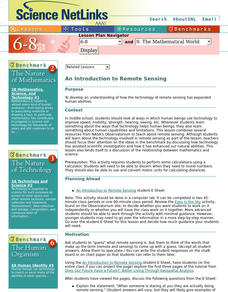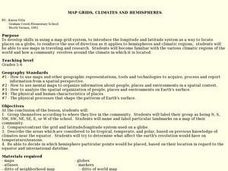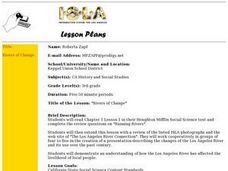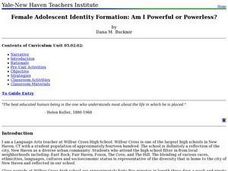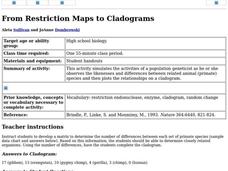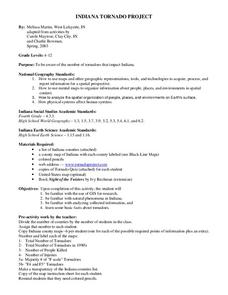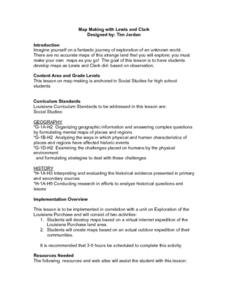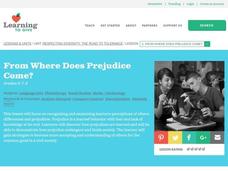Curated OER
Hold Off on the Headphones
Learners determine that waves carry energy and information from one place to another. They determine that wavelength, frequency and wave speed are related and describe that sound is a longitudinal wave whose speed depends on the...
Curated OER
From Corn To Tortillas
Students investigate the food known as the tortilla. They research the growth cycle of the corn plant and how tortillas are made from it. The importance of the tortilla according to the Hispanic culture is explained to the students. The...
Curated OER
Vibration and Pitch
Fifth graders investigate the relation between vibrations and pitch. They observe and discuss an experiment involving a bicycle and a piece of cardboard in the spokes, listen to a comb with cardboard, and listen to various sounds and...
Curated OER
What's Mongolia Really Like?
Learners look at rural Mongolian nomadic culture through the eyes of a Peace Corps Volunteer and examine the dynamics of a people in transition. They give one important reason for migration from a rural to an urban setting and explain...
Curated OER
Going in Cycles: The Life of an Aluminum Can
Students explore the life cycle of aluminum cans. In this recycling instructional activity, students review the manufacturing process and how to make a closed loop cycle. Students also have the opportunity to present what they've...
Curated OER
Dinosaurs 1: Where Are the Dinosaurs?
Students explore dinosaurs. In this dinosaur identification lesson, students watch video clips for different dinosaurs from the Discovery Kids website. Students discuss the clips with their teacher. Students may then role play the...
Curated OER
Sampling Rocks
Pupils study rocks they find on the playground. In this investigative lesson plan students collect and analyze rocks they find and answer questions about them.
Curated OER
Geography Tutor: Five Themes of Geography: DVD-Video Assignment
In this geography skills worksheet, students watch the National Geographic video "Five Themes of Geography." Student then respond to 8 short answer questions about content of the video.
Curated OER
Water Filtering
Young scholars investigate how polluted water is filtered so people can use this recycled resource. They conduct an experiment in which they put "polluted" water through a filtering system. They investigate what happens at a water...
Curated OER
MAP GRIDS, CLIMATES AND HEMISPHERES
Students compare/contrast the grid and latitude/longitude system used on a globe. They describe the areas which are considered to be a tropical, temperate, and polar, based on knowledge of climates.
Curated OER
Rivers of Change
Third graders examine rivers and how they affect the people living around them. They read a chapter in their science text, take a virtual river tour online, read a background information story, and in pairs describe the changes in the...
Curated OER
Female Adolescent Identity Formation: Am I Powerful or Powerless?
Students explore the "coming of age" process experienced by adolescent girls on their journey from children to adulthood. They focus on the middle years or limbo period in which girls decide who they want to become as women or rather,...
Curated OER
From Restriction Maps to Cladograms
Learners develop a matrix to determine the number of differences between each set of primate species. They determine closely related organisms then complete the cladogram and answer a set of questions.
Curated OER
Indiana Tornado Project
Learners become aware of the number of tornadoes that impact Indiana. They explore basic facts about tornadoes. Students use the GIS for research. They explore that natural phenomena in Indiana. Learners become familiar with...
Curated OER
Wetland Ecosystems: Non-living and Living Components and Brine Shrimp
Students explore wetland ecosystems. In this wetland lesson, students discuss and observe salt ponds and the organisms that live there. They explain how abiotic and biotic factors of species are important to survival.
Curated OER
Visual Pictures of the Buffalo National River
Students create art in a Buffalo National River unit. In this Buffalo River art lesson, students create woven rugs, make baskets, create pottery bowls, build log cabins, and construct tipis. They create a bulletin board where the...
Curated OER
Under the Weather
Students consider the increase in floods. In this current events lesson, students visit selected websites to research the occurance of floods in Britain.
Curated OER
FUN WITH MAPS
Second graders receive a general overview about how maps are made and used, how specific information can be derived from them, and how a student can gain personal information about their surroundings from examining them.
Curated OER
Water Pollution - Group Presentation
Pupils investigate water pollution at a web site and apply it toward a group presentation.
Curated OER
Exploring Folk Traditions and Folk Beliefs
Ninth graders work together to brainstorm an idea to focus on the similiarties and differences between various cultures. Individually, they interview family members using questions they created based on their topic. They use their...
Curated OER
Map Making with Lewis and Clark
Students develop maps based on a virtual internet expedition of The Louisiana Purchase land area. They create the maps based on an actual outdoor expedition of their communities. Student create two maps, one based on the Louisiana...
Curated OER
Failing Ecosystems: Haiti and the Caribbean
Ninth graders study the impact that climate has on the land. They discuss how deforestation leads to erosion and soil damage and how trees and vegetation help to stabilize the land. They draw a large map of the Caribbean and show Haiti...
Curated OER
From Where Does Prejudice Come?
Students explore the concept of discrimination. In this social studies instructional activity, students view pictures and write down the first thing that comes to their mind. Students discuss if stereotyping or prejudice affected their...
Curated OER
Quadrate Lab
Learners investigate tree stems and conduct an experiment on how non living factors affect living factors. In this tree stems lesson plan, students observe and record physical characteristics, and make predictions on what factors will...








